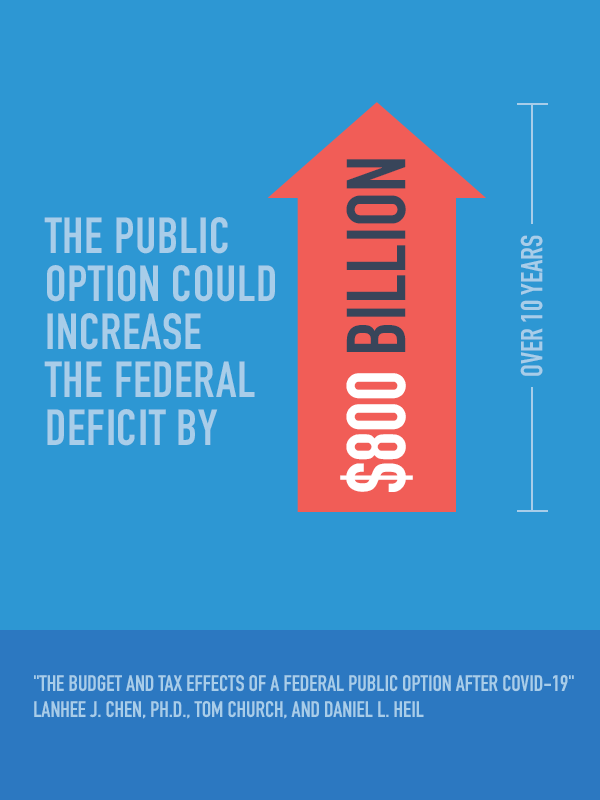New Study: The Public Option Could Lead To A $2,500 Per Year Tax Increase For The Average American Family

WASHINGTON – A new study released today by Lanhee J. Chen, Ph.D., Tom Church, and Daniel L. Heil of the Hoover Institution with support from the Partnership for America’s Health Care Future reveals that during this critical time, a new government-controlled health insurance system known as the public option could be more expensive for working families than original projections. In fact, the study reveals the public option could raise “taxes on middle-income families by over $2,000 a year,” or “increase deficits by almost $800 billion over ten years.” This deficit increase is $100 billion larger than estimates from an earlier study conducted in January, which found the public option could have increased 10-year deficits by $700 billion.
According to the new study, the public option “would eventually become the third-largest government program. The prospect of a costly new government program comes at an inopportune time … Without major spending reforms, avoiding this unprecedented increase in the federal debt will require significant tax increases. Policymakers must account for this prospect before enacting new spending programs. This is particularly true when considering expensive programs like a politically realistic public option, which would likely require further tax increases.”
The study finds the average American family could eventually see their payroll taxes increase by more than $2,500 a year – a $200 increase from a January estimate. Alternatively, another way to finance the public option could increase personal income tax rates by 18 percent across the board, pushing the top marginal tax rate to over 50 percent.
Key Findings:
- During this critical time, financing a politically realistic public option would be more expensive than initially calculated. The average American family could eventually see their payroll taxes increase by more than $2,500 a year – a $200 increase from a January study.
- Alternatively, another way to finance the public option could increase personal income tax rates by 18 percent across the board, pushing the top marginal tax rate to over 50 percent.
- Further, under a different scenario, politicians could finance the public option by increasing the Hospital Insurance payroll tax by 180 percent in 2050 – increasing taxes for working families by $3,900 a year to pay for the public option and return the federal debt to pre-COVID-19 projections.
- Over 30 years, the public option would become the third most expensive government program behind only Medicare and Social Security – both of which are already at risk for the seniors who rely on them.
- Without tax increases, the public option could add as much as $800 billion to the federal deficit in its first 10 years – $100 billion higher than initially estimated.
“This new study adds to the mounting evidence that the public option could burden American families with new, unaffordable costs,” said Lauren Crawford Shaver, the Partnership’s executive director. “We should build and improve on what’s working in health care where private coverage, Medicare, and Medicaid work together to expand access to coverage and care — not start over with a new government-controlled system like the public option.”
- To read the complete study, CLICK HERE.
- To learn more about the public option, CLICK HERE.
- To learn more about the Partnership for America’s Health Care Future, CLICK HERE.
About the Authors: Lanhee J. Chen, Ph.D. is the David and Diane Steffy Fellow in American Public Policy Studies at the Hoover Institution and Director of Domestic Policy Studies in Public Policy at Stanford University. Tom Church and Daniel L. Heil are policy fellows at the Hoover Institution.
About the Partnership for America’s Health Care Future: The Partnership for America’s Health Care Future’s (PAHCF) mission is to build on what’s working in health care and fix what’s not. Every American deserves access to affordable health coverage and high-quality care. Our health care system allows tens of millions of patients and families to receive world-class care delivered by world-class doctors and hospitals. But we can and must do more to ensure health care works for all Americans. That’s why the nation’s leading doctors, nurses, clinicians, community hospitals, health insurance providers and biopharmaceutical companies want to work together to lower costs, protect patient choice, expand access, improve quality and foster innovation. And whether it’s called Medicare for All, Medicare buy-in or the public option, one-size-fits-all health care will never allow us to achieve those goals. That’s why we support building on the strength of employer-provided health coverage and preserving Medicare, Medicaid and other proven solutions that hundreds of millions of Americans depend on – to expand access to affordable, high-quality coverage for every American.